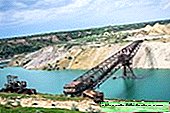Valley of the Dead Excavators
Morozovsky quarry is one of the largest coal mines in Ukraine. Some 5 years ago, work was in full swing here. Every hour, huge walking excavators shipped hundreds of KAMAZ coal. Now they are slowly rusting and waiting to be scrapped. Soviet technology, 70s, and German, still pre-war. This post is about the iron monsters of the Morozovsky quarry.

The Morozovsky open pit is one of the few places in Ukraine where brown coal was mined. The company with grief in half survived the 90s and until recently worked. In 2009, companies cut off electricity for debts. The equipment got up, the staff was reduced, the quarry was quickly filled with groundwater. Reclamation awaits the section - they say that the Chinese want to develop it.

Recently, Morozovsky quarry is very popular among Ukrainian industrial fans. True, every month there are less and more “exhibits”, and getting to them is becoming more difficult. The quarry is well guarded.


According to estimates, coal deposits here will last for another 20 years for active mining.

The main attraction of the career is a huge rotary excavator. The bottom left is the usual one - you can compare the sizes.

The name of the monster is ERShR-1600. With marking, everything is simple: a walking-rail rotary excavator, productivity - 1600 cubic meters per hour. To make it clear, this is about 200 KAMAZ trucks. I repeat - per hour!
Machine built in 1970. Parts were brought separately for several years, and here, on the spot, the workers collected this monster.

The colossus weighs 4,000 tons. No, I didn’t seal it - four thousand. This is about 80 railway passenger cars. In girth it’s real almost from my Khrushchev-five-story building.

He moved at a speed of two meters per minute. Slowly but surely)
This excavator was developing a quarry. He walked along the edge, cut off the top layer, after which draglines began to mine coal, and he went down to a lower level and dug there.

The huge wheel at the end of the boom is actually a rotor. Diameter is 16 meters. 10 buckets were attached to it. They were cut for scrap.

Dragline. He is a walking excavator ESh-6/45. With marking, again, nothing complicated. Letters are just an abbreviation. Numbers indicate bucket volume (in cubic meters) and boom length, respectively.
NKMZ - Novokramatorsky Engineering Plant. Among the rust, Lenin's profile still appears.

Such excavators were produced from the beginning of the 70s to the end of the 80s. In total, the draglines of this class NKMZ riveted more than 300 pieces. They were delivered to all countries of the social camp.


Paws) It is with them that he "walks."

This is the only excavator that managed to climb and even climb inside.

And this is his older brother. It is one and a half times more. The length of the boom is 70 meters. For comparison, this is the standard width of a football field.

Just incredible colors. I have never seen such a combination in nature.


There is more water every year. Locals say the depth is "three pillars high."

They say that every day the water level rises by 1 cm.
Under water - a power line, conveyor and much more. Almost drowned and one of the walking excavators. In the photo they seem small. In fact, the arrow of the right excavator is 70 meters, the bucket is 10 cubic meters. From afar, they resemble the skeletons of some dinosaurs. Or giraffes.
On the left on the hill is our old friend whom we climbed.

The conveyor bridge is the only one in the country. Captured. The bridge was brought from Germany after the Second World War. There, it has been used since 1929 at a coal mine in the city of Bregwitz.


Also, this bridge is called dump truck. I don’t know what the difference is. It seems like he’s self-propelled.

Back in his career, it seems like there are two old German excavators. But either I didn’t reach them, or they had already been cut into metal. We are not living in Germany, so no one will make a museum of iron monsters. So, if you want to see them live, hurry.

















